- Jul 22, 2015
- 2,724
Ok - to levelset before we get into the weeds...
This is for a Sierra 1500HD, with 9.25 front diff. 3.73 gear, but I don't think that is relevant here...
First, some pics for reference... (all are from the left / driver's side; the RH side is leak-free, currently)
Orientation - 1-3 'under' diff, looking 'up'
4-8 are 90' off - flip 'rightward' for correct orientation (I tried to reorient; they show up ok on my PC, but not here... (known issue, it appears))
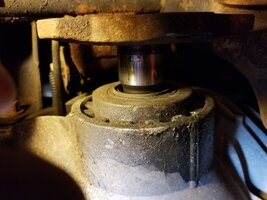
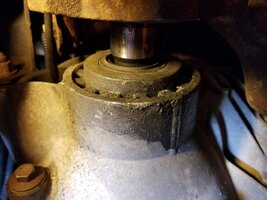
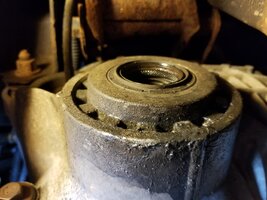
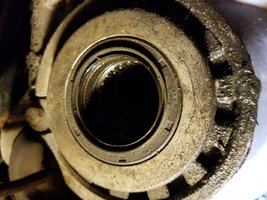
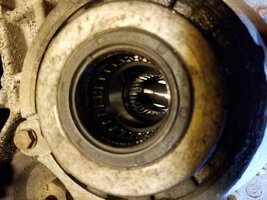
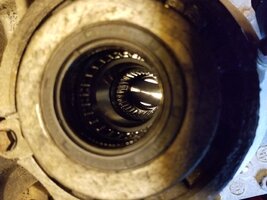
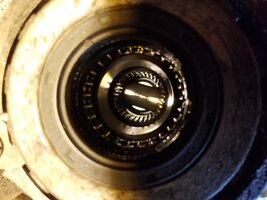

Pics 1-2 have the axle shaft in for reference only. I was amazed (read: pleased) at how easily I was able to remove the shaft - with circlip intact. Yay me.
Fluid has been drained, but you can see...this is a fairly substantial leak. While I didn't measure the amount that came out (I can still do so), I'd estimate at least a quart was drained (cap is 1.8 qt, so we'll assume it was no less than half full). No (known) noises when I've engaged 4Hi / 4Lo, to check their operation.
My assumption prior to pulling the axle shaft was that the outer seal needed replacing - and I have a Timken, ready to go.
However (starting at pic 4 forward)... it doesn't appear *to me* that the fluid is coming from the outer seal area, but from *behind* it (that darker gray section with the retaining clip / bolt is ident'd as the Front Bearing Differential Adjuster - which seems (?) to be the source of the leak.
Looking at the service manual, when we start talking about R&R of that Adjuster, GM starts talking about special tools, preload this / that, etc., etc.
Online, when I look for leak resolution on the 9.25", people talk / show mostly outer axle seals, and sometimes the 'bearing' - but in all cases, the work is done without touching the adjuster 'cover'.
I'm fine with getting more parts, as needed (if I need to replace the bearing, I'll get one of the improved versions, with 'end to end needles' in the bearing race - which doesn't look especially bad, to my untrained eye, btw.)
What I don't want to do is put on the outer seal and find out I'm still leaking, later.
Thoughts? Replies appreciated, as always. I'm not in an extreme rush. And I don't penalize on longish posts...LOL
This is for a Sierra 1500HD, with 9.25 front diff. 3.73 gear, but I don't think that is relevant here...
First, some pics for reference... (all are from the left / driver's side; the RH side is leak-free, currently)
Orientation - 1-3 'under' diff, looking 'up'
4-8 are 90' off - flip 'rightward' for correct orientation (I tried to reorient; they show up ok on my PC, but not here... (known issue, it appears))








Pics 1-2 have the axle shaft in for reference only. I was amazed (read: pleased) at how easily I was able to remove the shaft - with circlip intact. Yay me.
Fluid has been drained, but you can see...this is a fairly substantial leak. While I didn't measure the amount that came out (I can still do so), I'd estimate at least a quart was drained (cap is 1.8 qt, so we'll assume it was no less than half full). No (known) noises when I've engaged 4Hi / 4Lo, to check their operation.
My assumption prior to pulling the axle shaft was that the outer seal needed replacing - and I have a Timken, ready to go.
However (starting at pic 4 forward)... it doesn't appear *to me* that the fluid is coming from the outer seal area, but from *behind* it (that darker gray section with the retaining clip / bolt is ident'd as the Front Bearing Differential Adjuster - which seems (?) to be the source of the leak.
Looking at the service manual, when we start talking about R&R of that Adjuster, GM starts talking about special tools, preload this / that, etc., etc.
Online, when I look for leak resolution on the 9.25", people talk / show mostly outer axle seals, and sometimes the 'bearing' - but in all cases, the work is done without touching the adjuster 'cover'.
I'm fine with getting more parts, as needed (if I need to replace the bearing, I'll get one of the improved versions, with 'end to end needles' in the bearing race - which doesn't look especially bad, to my untrained eye, btw.)
What I don't want to do is put on the outer seal and find out I'm still leaking, later.
Thoughts? Replies appreciated, as always. I'm not in an extreme rush. And I don't penalize on longish posts...LOL


